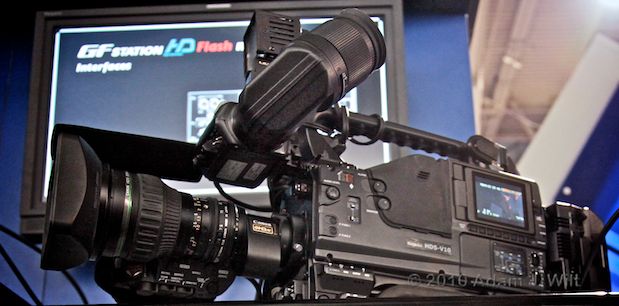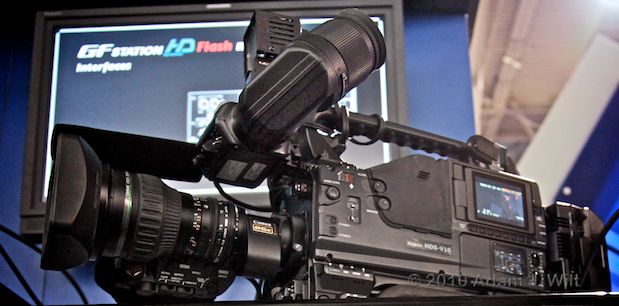
Ikegami HDS-V10 GFCAM tapeless 2/3″ 3-CCD camcorder.
In between the DSLRs and the 3D rigs, there were a few “traditional” broadcast cameras (like the Ikegami V10 shown above), small-format camcorders, and digital cinema cameras to be seen. Here are some of them.
“Traditional” Cameras
Canon XF300 1/3″ 3-CMOS camcorder showing its flip-way-out LCD.
I previously mentioned the new Canons—1/3″ CMOS handhelds with a new 50 Mbit/sec 4:2:2 MPEG-2 codec recording on CF cards. They’re clearly descendants of the HDV-format XH A1 and XH G1 camcorders, but just as clearly they show a number of improvements beyond those models. In the image above, the oversized LCD (which can be swung out on either side of the camera as well as folding 45 degrees farther back than normal) shows a focusing display; the “grass” among the bottom of the picture grows taller as fine detail within the image sharpens up.
Canon CXF300 waveform monitor display.
The new Canons offer both waveform monitor and vectorscope overlays on their LCDs. The EVF remains unaffected by these overlays, so you can leave the WFM displayed if you want and just use the EVF for composition.
Canon VX300 lens and controls.
The lens offers hard-stopped manual focus as well as full auto focus. The lens collar behind the focusing ring, with the focus window cut into it, rotates between a “manual” and an “auto” position to make the selection. When you turn it to the “auto” position, the focusing scale cleverly slides back, disappearing behind/beneath the collar—you’ll never glance at the auto-focusing lens and mistakenly think a manual focus point has been selected.
JVC GY-HM790 1/3″ 3-CCD camcorder, the HM700’s more capable brother.
We saw this HM790 before, too, but I wanted to show some of its details.
I/O connectors and SDHD card slots on the 790.
The 790 builds on the earlier 700 mostly by building out connectivity and controllability: the 790 can handle genlocked multicamera shoots, ASI, analog pool feeds, triax and fiber cabling, and remote controls with greater ease than last year’s 700. Yes, the 700 can do all that, too, but the 700 requires a studio-style “sled” for may things that the 790 can handle unencumbered (though the 790 can also be sled-mounted, of course).
The JVC’s big, detailed flip-out LCD.
The 790, like the Canons, has a gratifyingly large and detailed LCD, which makes finding focus a lot less painful.
Panasonic AG-HMC80 1/4″ 3-CMOS AVCCAM… with DV recording, too.
The HMC80 is a shoulder-mount companion to the small, handheld HMC40. Aside from its obvious differences, it adds standard-def recording using AVI-wrapped DV files.
This is a Big Deal: DV files are universally editable these days, and can be cut quickly and easily on any Mac or PC from the past decade. Many competing AVCHD camcorders offer SD recording—if they offer it at all—using a more cumbersome, DVD-derived MPEG-2 codec. Their SD files may be more space efficient but they are more difficult to edit, requiring more powerful computers and a more limited selection of compliant NLEs.
The HMC80 ships in September and will list for about $2900.
The HDAVS booth at NAB.
HDAVS is a mainland Chinese company exhibiting at NAB for the first time, though they’ve been shipping video products in China for five years. Their E2 system uses hard disk and flash memory “DataCam” packs.
HDAVS HDC-680 2/3″ 3-CCD HD camcorder.
The 680 camcorder has a dual-slot design allowing both mirrored and ping-pong recording modes. The camera records I-frame-only 4:2:2 MPEG-2 at 100 Mbit/sec or long-GOP 4:2:0 MPEG-2 at 50-80 Mbit/sec.
Operator’s side of HDAVS HDC-680 camcorder.
Most controls are in their familiar places despite the occasional Chinese character. I was told that the CCDs are from Panasonic and the hard drives are from Hitachi.
HDAVS DDC-280 2/3″ 3-CCD SD camcorder.
There’s also a standard-def version, the 280. It also uses the E2 DataCam packs.
Next: Digital Cinema Cameras…
Digital Cinema Cameras
Arri’s Michael Bravin talks to the press.
Arri’s Alexa camera was very popular; the Arri booth was jammed.
Alexa’s right side is a large, assistant-friendly control panel.
All the buttons are backlit for use on dark stages.
Detail of the assistant’s panel.
The operator’s side has only those controls the operator needs.
Using the rotary dial to select an output format.
Panasonic’s mockup of the AG-AF100 Micro 4/3rds 1-CMOS camera.
Panasonic showed a “balsacam” mockup of their entrant into the low-cost, large-format camera market, the AF100. It’s based on the Micro Four Thirds format, the same sensor size (17.3 x 13mm active area) as used on the video-capable GH1 still camera, among others. Shipping in December at around $6000, or so it is claimed.
Relative image sizes compared.
Micro Four Thirds is just a bit smaller than a standard 35mm motion picture frame, but a lot larger than the active area of a 2/3″ video sensor.
Left rear corner of the AG-AF100 balsacam.
The general configuration is that of a bulked up, interchangeable-lens HVX200 (Sony showed their own single-chip, affordable cine-cam mockup at their press conference; its overall design is very similar).
Right rear corner of the AG-AF100 balsacam.
Note the handgrip placement; great for balancing the body front-to-back, but I have grave doubts about both the Panasonic and Sony designs: I don’t think the rear-EVF, side-grip style scales up from already heavy handheld handycams to even heavier, interchangeable-lens cine cams. We’ll see…
A small selection of compatible lenses.
One benefit of Micro Four Thirds is the shallow flange depth. If a Micro Four Thirds lens isn’t to your liking, almost every other cine or still lens mount uses a deeper flange depth, so it’s easy to find a mount adapter to make it fit. Nikon, Canon, Olympus, and other still lenses as well as PL-mount cine lenses are readily adapted.
Ikonoscop A-cam dII and flash mag.
At the CML gathering, Ikonoscop showed off two prototypes of their A-Cam, a very compact digital cine camera.
The A-Cam’s battery and recording media reside behind a rubber cover.
The camera uses a Super16mm-sized single CCD capable of recording up to 60fps at 1920×1080. It records to an 80 GB on-board flash pack.
Side view of the Ikonoscop A-Cam dII.
The camera was built from the sensor on back; the EVF is inset to keep the body as compact and streamlined as possible. The EVF pivots up and down a certain amount. In handheld use, one grips the camera around its “waist” with the right hand and holds the EVF to one’s eye. I found the camera surprisingly comfortable to hold; I had to turn my head very slightly to the right to fit my eye to the eyepiece, but the smooth contours of the camera, its light weight, and its neutral balance made it a pleasure to pick up. I’m reminded of the Nizo S560 I used in the late ’70s, another rounded-rectangle camera that handheld a lot better than its rectilinear design would lead you to believe.
An A-Cam on an Element Technica shoulder mount.
Of course you don’t have to handhold the naked camera; it’ll work with standard support gear, too.
Ikonoscop, Aaton Penelope Digital, and Phantom Flex cams.
One rickety wooden cocktail table at the Greek Isle casino held four priceless prototype cameras. As Abel Cine’s Mitch Gross said, “just think of how many millions of development dollars are present here on this table.”
Phantom Flex, Aaton Penelope Digital, and Ikonoscop cams.
Just think, indeed… but then the very loud Elvis tribute singer showed up, to boost the ambient noise level from annoyingly uncomfortable to painfully intolerable. I beat a hasty retreat, fearing for my hearing…
You want more? I’ve got more: video clips of the Aaton, two Sonys, and the $300 GoPro Hero and the hoopla surrounding it.
16 CFR Part 255 Disclosure
I attended NAB 2010 on a press pass, which saved me the registration fee or the bother of using one of the many free registration codes offered by vendors. I paid for my own transport, meals, and hotel.
No material connection exists between myself and the National Association of Broadcasters or the various exhibitors I report on (except as noted in my articles, when and if necessary); aside from the press pass, NAB has not influenced me with any compensation to encourage favorable coverage.

